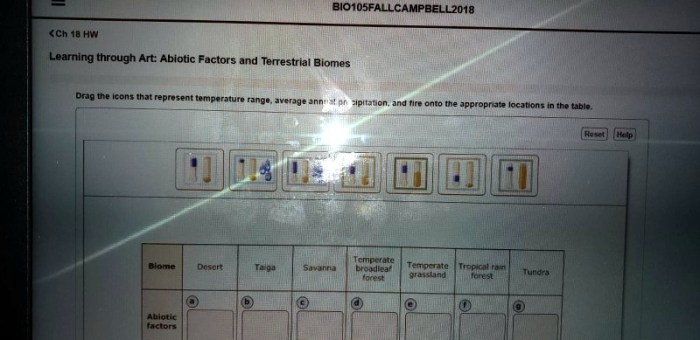Learning through art map of terrestrial biomes – Unveiling the beauty and diversity of Earth’s terrestrial biomes through art, this comprehensive guide introduces a novel approach to learning. By harnessing the power of artistic expression, educators can captivate students, fostering a deep understanding and appreciation for the intricacies of our planet’s ecosystems.
This learning map seamlessly integrates visual representations, interactive elements, and multimedia resources, creating an immersive experience that engages students on multiple levels.
Learning through Art Map of Terrestrial Biomes

Art offers a captivating medium to facilitate learning about terrestrial biomes, immersing students in the exploration of diverse ecosystems through visual representations, interactive experiences, and multimedia resources.
Elements of a Learning through Art Map of Terrestrial Biomes
An effective learning map should incorporate:
- Visual representations of biomes, such as paintings, photographs, and diagrams, to illustrate the unique characteristics of each ecosystem.
- Interactive elements, such as simulations, games, and virtual tours, to engage students in hands-on exploration and foster deeper understanding.
- Multimedia resources, such as videos, podcasts, and articles, to provide additional context and enrich the learning experience.
Biome-Specific Art Activities, Learning through art map of terrestrial biomes
Tailored art activities can enhance biome exploration:
- Tropical Rainforest:Create collages using vibrant leaves, flowers, and animal prints to represent the lush biodiversity.
- Desert:Paint landscapes depicting the arid conditions, incorporating sand textures and geometric shapes to evoke the unique desert environment.
- Tundra:Construct sculptures using materials like ice and snow to capture the frozen landscapes and explore adaptations of tundra species.
Assessment and Evaluation
Assessment can be integrated through:
- Student presentations:Have students present their art projects and explain how they reflect the characteristics of specific biomes.
- Reflective journals:Encourage students to document their learning journey, connecting art-based experiences to their understanding of biomes.
- Teacher observation:Monitor student engagement, participation, and understanding throughout the learning process.
Classroom Integration
The learning map can be integrated into lessons by:
- Art as a starting point:Begin lessons with art activities to spark curiosity and introduce biome concepts.
- Interdisciplinary connections:Link art projects to science, geography, and environmental studies curricula.
- Differentiated instruction:Provide students with art activities that cater to their individual learning styles and interests.
Collaboration and Sharing
Collaborating with art educators can enhance the learning map’s design and content. Additionally, sharing the map through online platforms or workshops can benefit a wider audience.
Question & Answer Hub
What are the key elements of an effective learning map for terrestrial biomes using art?
A successful learning map should include visual representations, interactive elements, multimedia resources, and biome-specific art activities.
How can art enhance student engagement in learning about biomes?
Art provides a hands-on, experiential approach that fosters creativity, critical thinking, and problem-solving skills.
What are some specific art activities that can be used to explore different biomes?
Students can create biome-inspired paintings, sculptures, collages, and dioramas, each reflecting the unique characteristics of the ecosystem.



